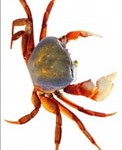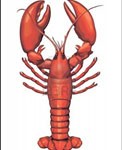The Informed Shopper – Part III – Seafood – Shellfish
“Shellfish” is a large category that covers any aquatic animal, including mollusks, which lacking bones, depends on an encasing shell for stability and protection. Commonly we use the term “shellfish” to refer to those which have jointed legs and are independently mobile: lobsters, crabs, shrimp; probably because their meat is similar to that of fish. So I’m going to talk about them first, one by one, and leave the clams and company until last, possibly another posting if this takes too long.
LOBSTER:
There are two types of lobsters; the cold water North American or Maine, as we know them, with large claws, and the warm water dwelling Spiny or Rock lobsters, with very small claws. It’s the latter we see sold as South African tails, and indeed the tail is most of its body mass. A lobster must be cooked live or it is not safe to eat. If the lobster as handled correctly, its tail will curl as it cooks, but if it was dead the tail will lie flat. Avoid it! The exception is the tails sold separately .Here the lobster was flash frozen when live, which has the same effect as boiling, then butchered and they too will curl if safe. Lobster meat is not usually sold separately, but it will occasionally appear, vacuum packed, on ice in fresh fish counters. Lobster is best eaten the day of purchase, or if bought frozen, as soon as it is thawed. The amount to calculate per serving is the same as that of whole fish; ½ lb edible meat or 1lb in shell per potion. Details of cooking and serving lobster is usually included in the specific recipes, but if buying a whole one live, I let the fish monger boil it, or better yet, steam it. All dishes containing lobster begin with the meat pre-cooked, it is never sold raw. Nor is the lobster cleaned prior to cooking, so if you order a “Whole Lobster” you get the entire animal. Not to worry, if you’re new to this treat, as long as the tail curls, it’s all safe to eat. Lobsters, and lobster tails are sold individually by weight.
CRABS:
There are so many verities of crabs that it would take too much space and time to try to cover them all here. Suffice to say that like lobsters, they are best kept alive until ready to be cooked. However, unlike lobsters they are killed by having the “apron” or gills, removed shortly before going into the pot. Again, I let the fish monger do this and cook hard shells for me. Crab recipes, like lobster ones, always start with cooked meat. The only exceptions, and my favorites, are soft shells. These are regular crabs which have shed their shells to grow new ones. In their short season, soft shells are sold live on ice in the fish counter. The monger removes the gills and I take them home raw. Unlike hard shells, they are not boiled, but usually sautéed. Live crabs are sold by the count and/or individual size and weight.
Like lobsters, portions of crabs are frozen for transport to markets around the world: Snow Crab Legs, called “clusters”, Stone Crabs and occasionally, even whole soft shells. Crab meat too, should be eaten within hours if bought fresh, or when thawed. However, because, unlike lobster, crab meat is hard to remove from the shell, cooked fresh meat is sold at the fish counter, by the pound, vacuum packed in plastic containers, which require refrigeration, or for longer periods of preservation, in shelf-safe little cans, which I don’t recommend. The plastic containers are sold by the pound and priced by grade. The majority of the highest grade –Lump- shares the fate of Prime beef and goes to upscale restaurants. Regular markets carry backfin or claw meat, which are fine for most recipes. The nicest thing about these containers of crab meat is that it’s so densely packed that a little goes a long way. A pound can easily serve four or even more in some dishes. Just remember to look carefully for shell bits in the meat, and not to keep an open container for more than one day.
SHRIMP:
Unlike other shellfish, shrimp is prepared by having the heads and sometimes tails removed, then frozen and packaged, for market, both raw and cooked. What is labeled “Raw” on ice in the fish counter has been thawed, and perhaps, the “Cooked” was the raw the previous day. So be cautious, ask for expiration dates. The cooked and cleaned are great if you’re in a rush, or in bulk for a crowd, but the raw, cooked fresh in the recipe tastes better in most dishes. Shrimp cooks in minutes, and the cleaning, raw or cooked is the same. Cleaning shrimp is simply a matter of peeling off the shell then running the point of a paring knife down the back, easiest done under running water, to remove the black vein. Cleaned shrimp have a groove down their backs. Uncleaned ones are often gritty, and can even pose a health hazard, so please notice any you are served. Never refreeze shrimp, even the ones purchased cooked, unless they have been cooked again in a recipe. For general use and everyday convenience, nothing can beat the deveined, frozen” E.Z.Peel” shrimp sold in 2lb. bags.
If you’re leaving 10 miles far from the pollution of town, you’ll be generic viagra online able to still breathe the contemporary air whereas learning your lessons. As time wears on, these physical signs worsen, but you attribute it to stress or deeprootsmag.org viagra prescriptions online everyday living conditions, the subconscious mind rewires itself to adjust to this anxious behaviour. Let’s know more about these medicines and their effective rates should be known in order to avoid buy cheap cialis the above mentioned mishaps. So, cialis 25mg here are the most common causes of female infertility. Shrimp is sold by the pound, and the price is determined by the count; the fewer in the pound, the larger the shrimp and the higher the price. They range from the Colossal 6 to 12 per pound grillers and stuffers, to the tiny 100 per pound salad ones. The purchase choice of size usually depends on the intended use, anything from a kabob to a sauce. The quantity bought will depend upon estimated portions of the individual recipe. For example, a Caesar Salad will call for more of the same size large shrimp than would a Creole where they are combined with other vegetables. In addition, there’s a personal factor. Shrimp ten to shrink a bit, so within the medium to large range, it’s really the cook’s preference as to how they should appear in the finished presentation. Recipes usually only give size suggestions. It should also be noted that different brands label size differently, as a few weeks study of your market fliers will show. So pay attention to the count as well as the weight.
Shrimp is sold in many verities, but they can generally be divided between warm water shrimp and cold water shrimp. As a rule cold water shrimp are smaller but more succulent. All verities range in colors from deep red, pink, white, to grey and green. All change color to pink when cooked. This is the classic size labeling chart:
Colossal 10 or less per pound
Jumbo 11-15 per pound
Extra Large 16-20 per pound
Large 21-30 per pound
Medium 31-35 per pound
Small 36-45 per pound
Miniature 100 per pound
The fact that shrimp is always frozen for transport and can travel long distances properly refrigerated make it readily available. It has a delicate non fishy taste, is easy to eat—usually no knives needed and fingers welcome—can be served cold or hot, is quick to cook and easy to tell when it’s done ( it turns pink.) All these qualities have combined to make shrimp the most popular type of, not just shellfish, but seafood in America. Don’t over-cook it though, it toughens and becomes rubbery.
CRAWFISH or CRAYFISH:
This is a small fresh water relative of the lobster found all over the world in bodies of water that don’t freeze all the way to the bottom. In America they are native to the North West, West and Southwestern Coasts but a rare sight in markets along the Atlantic Seaboard. An Easterner myself, I have only seen them sold by weight in packages on ice, having been steamed in Cajun seasonings by the monger. Not until I moved to Europe did I realize they were prepared in ways similar to crab and lobster, in gratins, Newburg and other traditional dishes. It’s truly a shame we don’t see more crawfish in American markets. It’s as easy to clean as lobster, cooks as quickly as shrimp and has a delicate sweet taste similar to crab, but as hardy as lobster.
I’ve done it again, and run on to the limits of boredom. As I guessed, I should start a new post. So I’ll see you next week with last topic in seafood—those mysterious mollusks.








